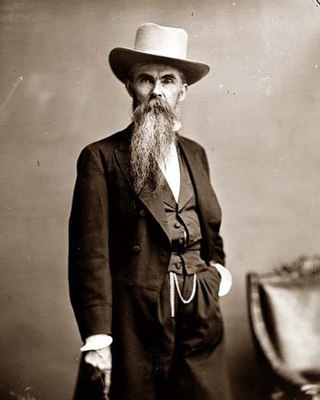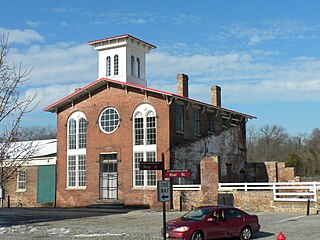
Prince George County is a county located in the Commonwealth of Virginia. As of the 2020 census, the population was 43,010. Its county seat is Prince George.

Petersburg is an independent city in the Commonwealth of Virginia in the United States. As of the 2020 census, the population was 33,458. The Bureau of Economic Analysis combines Petersburg with Dinwiddie County for statistical purposes. The city is 21 miles (34 km) south of the commonwealth (state) capital city of Richmond.

Chesterfield County is located just south of Richmond in the Commonwealth of Virginia. The county's borders are primarily defined by the James River to the north and the Appomattox River to the south. Its county seat is Chesterfield Court House.

The Appomattox River is a tributary of the James River, approximately 157 miles (253 km) long, in central and eastern Virginia, named for the Appomattocs Indian tribe who lived along its lower banks in the 17th century. It drains a cotton and tobacco-growing region of the Piedmont and coastal plain southwest of Richmond.

William Mahone was an American civil engineer, railroad executive, Confederate States Army general, and Virginia politician.

The Richmond and Danville Railroad (R&D) Company was a railroad that operated independently from 1847 until 1894, first in the U.S. state of Virginia, and later on 3,300 miles (5,300 km) of track in nine states.

Drewry's Bluff is located in northeastern Chesterfield County, Virginia, in the United States. It was the site of Confederate Fort Darling during the American Civil War. It was named for a local landowner, Confederate Captain Augustus H. Drewry, who owned the property.

Otelia Butler Mahone from Smithfield, Virginia was a nurse during the American Civil War and the wife of Confederate Major General William Mahone, who was a civil engineer, teacher, railroad builder, and Senator in the United States Congress. Popularly known in Virginia as the "Hero of the Battle of the Crater" during and after the Civil War, her small-of-stature husband was nicknamed "Little Billy." An illustrious "character" in her own right, strong-willed Otelia Butler Mahone became almost as well known as her famous husband. She is credited by local legend with the naming of the towns of Windsor, Ivor, Wakefield, Waverly and Disputanta along the famous 52-mile tangent railroad tracks engineered and built by her husband between the cities of Suffolk and Petersburg. When he led the formation of the Atlantic, Mississippi and Ohio Railroad (AM&O) from three trunk lines across the southern tier of Virginia in 1870, wags claimed the initials stood for "All Mine and Otelia's."
Walter Gwynn was an American civil engineer and soldier who became a Virginia Provisional Army general and North Carolina militia brigadier general in the early days of the American Civil War in 1861 and subsequently a Confederate States Army colonel. He was a railroad engineer and railroad president before the Civil War, Florida Comptroller in 1863 and a civil engineer after the Civil War.

The Norfolk and Petersburg Railroad was built between Norfolk and Petersburg, Virginia and was completed by 1858. The line was 85 miles (137 km) of 5 ft track gauge.

The Southside Railroad was formed in Virginia in 1846. Construction was begun in 1849 and completed in 1854. The 5 ft gauge railroad connected City Point, a port on the James River with the farm country south and west of Petersburg, Virginia, to Lynchburg, Virginia, a distance of about 132 miles (212 km).

The Bermuda Hundred campaign was a series of battles fought at the town of Bermuda Hundred, outside Richmond, Virginia, during May 1864 in the American Civil War. Union Maj. Gen. Benjamin Butler, commanding the Army of the James, threatened Richmond from the east but was stopped by forces under Confederate Gen. P.G.T. Beauregard.

In 1836, the Virginia House of Delegates approved a charter for the City Point Railroad. City Point, Virginia, was just ten years old. The Lower Appomattox Company ran boats of cargo from Petersburg, Virginia, to the large port at City Point. The company knew that the port needed a rail road to be competitive in the 1830s even though this would only be the second rail road in Virginia. Large ships that were too large for Port Walthall or Petersburg had to load and unload at City Point. Goods for export arrived in Petersburg from farms and plantations by way of the Upper Appomattox Canal Navigation System. The Richmond and Petersburg Railroad bringing coal and goods to port was also chartered in 1836. Coal arriving by boat from the Clover Hill Pits in 1837 and goods would soon be taken on the Clover Hill Railroad to connect with the Richmond and Petersburg Railroad to export from the area ports.

The Tri-Cities of Virginia is an area in the Greater Richmond Region which includes the three independent cities of Petersburg, Colonial Heights, and Hopewell and portions of the adjoining counties of Chesterfield, Dinwiddie, and Prince George in south-central Virginia. Other unincorporated communities located in the Tri-Cities area include Ettrick, Fort Lee, and City Point, the latter formerly a historic incorporated town which was annexed to become part of the City of Hopewell.
The Battle of Port Walthall Junction was fought May 6–7, 1864, between Union and Confederate forces during the Bermuda Hundred Campaign of the American Civil War. Although initially successful, the Confederates were eventually defeated, allowing Union forces to cut a railroad. The Port Walthall Junction on the Richmond-Petersburg Railroad connected with the spur to Port Walthall.
The Seaboard and Roanoke Railroad was organized in 1833 to extend from the area of the rapids of the Roanoke River at its fall line near Weldon, North Carolina to Portsmouth, Virginia, across the Elizabeth River from Norfolk on the harbor of Hampton Roads.
The Richmond and Petersburg Railroad moved passengers and goods between Richmond and Petersburg from 1838 to 1898. It survived the American Civil War and eventually merged into the Atlantic Coast Line Railroad in 1900.

Thomas Muldrup Logan was an American soldier and businessman. He served as a Confederate general during the American Civil War, and afterward was greatly involved in railroad development in the Southern United States.

The Howlett Line was a critical Confederate earthworks dug during the Bermuda Hundred Campaign of the United States Civil War in May 1864. Specifically, the line stretched across the Bermuda Hundred peninsula from the James River to the Appomattox River. It was named for the Dr. Howlett's House that overlooked the James River at the north end of the line. The Howlett Line became famous as the "Cork in the Bottle" by keeping the 30,000-man strong General Butler's Army of the James at bay.

The Clover Hill Railroad was a railroad company that operated for 36 years in central Virginia near Richmond. The railroad was created to carry coal most efficiently from the Clover Hill Pits in Winterpock, Virginia, to further transportation points in Chester, Virginia, where it could be sold for a better price than on the Appomattox River in the Piedmont region. This made the railroad important to the Confederacy in the Civil War to ensure a supply of coal for munitions and iron working. The mines were dangerous for the miners, and many accidents occurred. The railroad had to be sold when coal mining declined so that new owners could find other uses for the railroad.


















